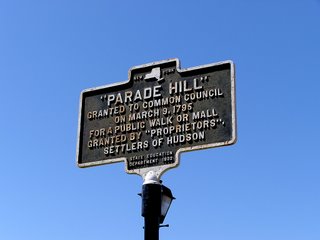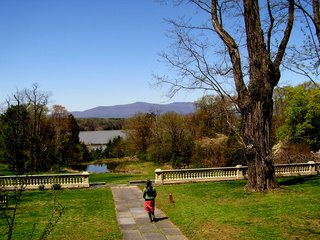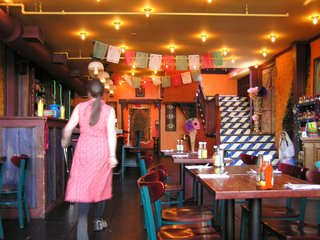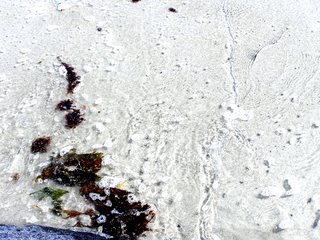This was only the second time I have ever been to Boston. It was a good visit all around--great weather. One of my very good friends, Kevin, lives there now and so I got to visit with him. He lives in Brookline and coincidently another friend of mine, Gabe, was staying there too. I hadn't ever been in that part of Boston and it was much less of a suburb than I would have guessed from what our roomate Hillary describes as the town she grew up in. We stayed with our friend Nick in Somerville, which is a part of town on the other side of the Charles River, north of Cambridge. It is another neighborhood I wouldn't have thought to be so well layed out and accessible to interact in. Boston has really great squares that function fully as public space even though they are often centered on economic exchange. Davis Square in Somerville was one of those places. Maybe I'll try to find a picture and post it later.
But, yeah, getting around was much easier this time and it was really great to see familiar faces in a large city that I didn't know. It was getting a bit tiring not having that familiarity. Though another familiar feeling that I wished I hadn't had to feel in Boston was a feeling of "being erased" as liz would aptly put it. We screened the film at the opening night of the New England Anarchist Book Fair. It was a really well attended and organized event that must have taken a lot of coordination. Yet, it was really startling how much it felt like the presence of Liz and me wasn't of much concern to anyone organzing the screening. Though I had been in communication with a person for quite a while about being a part of the event, it wasn't until we got to Boston and saw a poster for the opening that we realized how much we (liz and i as people) weren't really supposed to take part in the event. Our names weren't on the poster as the filmmakers, nor was there mention that we would be present and ready to facilitate discussion and answer questions if that was what people wanted to happen.
It was weird to see, but then when we got to the community church in copley square it was even weirder to feel uncomfortable setting up a table with our dvds, cds, and t-shirts. People weren't rude at all--they just weren't very welcoming. No introductions from anyone but Scott, the person I was in touch with when trying to coordinate a screening, and even then it wasn't really an introduction as much as a, "Do you know where scott is? Oh, you're scott? Hi. I'm courtney, this is liz. Is there a place we can put this stuff? Oh, here? Thanks." And then I found him again to remind him that we usually did an intro to the film and facilitated a Q & A--that was okay, whatever we wanted to do. So, it was cool. We sat and listened to the speakers and saw people that we recognized from doing interviews, but were shy to just go up and talk to them (though I did have a nice conversation at the end of the night with a person, Roger, that we had interviewed). There was a reception before the film was to start and the night was already running late--so it seemed like we should probably just have a short Q & A, if at all--but it was hard to find someone to talk to about what they wanted to have happen. The film was set up and we were sitting on the stage to introduce the 25th screening of the film. We were really tired at this point and the woman that was MCing for the night needed to pass the hat for all the people coming in from out of town for the book fair. She mentioned a couple people but failed to mention that we had also come from out of town and were on a north american tour--we never expect to get money--but it is weird to be waiting to introduce the film we have been on tour with and not be mentioned at all as being a guest in town. Was it because we solicited the LPC to screen the film in Boston? I don't know, but we weren't note worthy enough, I guess.
So we introduce the film--it plays. There is some concern about it's length because the night started late and the men that were speaking before the reception spoke over time--there was a band of two men that needed to get on stage after the film. While Liz was sitting at our table a random man came over to her TWICE and complained about the length of the film. He kept asking when it would be over--she apologized for being such a burden, but he didn't get the joke. As the movie was ending we realized that we shouldn't do the Q & A--it would take too much time. But, I couldn't see where Scott or the other people I recognized as organizers were through the crowd. I went up to the front and waited for a time that I could get someone's attention to let them know that we didn't think it would be wise to have a Q & A. But, as the credits came on screen the lights promptly went up and I was informed indirectly by a person on stage talking to the audience that we wouldn't really be having a Q & A--there would be a casual one while the band was setting up. No one even came over to where we were sitting and let us know. I don't know why. But it was obvious that the Q & A wasn't going to happen and that was fine. It was just really unthoughtful of the organziers not to at least let us know what they were thinking. Why was the time alotted for us most easily expendable--especially since it was known from the begining of the night that the event was running late?
It made me wonder if it was that important that we came at all and why it wasn't important enough to the organizers that they still hadn't introduced themselves or engaged in any sort of conversation with us about the event or what they were doing or anything, any polite conversation. The person MCing the event came over to the table as we were getting ready to pack up and the band was winding down. I thanked her for working that night and she responded that she was glad to do it--she had noticed only a week before the event that the night was full of white men speaking and she felt they needed to have some other people represented. A good observation, but one that falls pretty short with out her even knowing. We aren't men--Liz and I--but I guess the film isn't a person, even though we were planning to speak. Also, shouldn't it have been in the minds of the organizers even before they started putting the event together that the night shouldn't just be a representative sample of radical white men? She was well meaning--yet she unknowingly erased us. Just another time in the night where we weren't valued enough to be visible, to be thought of as real participants in the kick-off event or the weekend at all. Only while we were packing up our table were we told that we should have a table at the book fair the next day. I guess that is just an aside though. I wish this was more articulate, but I really just wanted to put something out there--a recounting of the nights events--one that maybe portrays how poorly people think out the way they treat people and how it is easy to erase people that are right in front of you. It's easy to not value what you don't have to consider. It's easy to not value people that aren't going to take the energy to be in your face or have the confidence to always assert themselves in every situation--especially if you are a (multi-)privileged person/community that has an oppositional identity that allows one to skirt around issues of privilege as simple as extending common courtesy and as easy to spot as gender privilege. Just because we're not aggressive about our accomplishments, our ideas, our works doesn't mean we don't get to be participants, doesn't mean we don't warrant the respect that a podeum and notes or a mic and a guitar warrants others. Watch out who you erase in your language and your actions, they might be your friends.


 At the historic mansion near Bard College (we don't know what it was exactly and there was no signage explaining who it belonged to).
At the historic mansion near Bard College (we don't know what it was exactly and there was no signage explaining who it belonged to).


 sunset in New Paltz, NY
sunset in New Paltz, NY At an amazingly decorated mexican restaurant in Hudson, NY (supposedly the "next Hamptons").
At an amazingly decorated mexican restaurant in Hudson, NY (supposedly the "next Hamptons").

 3 doors in Hudson, New York.
3 doors in Hudson, New York. a strange boarded up building with art covering it in Hudson, NY
a strange boarded up building with art covering it in Hudson, NY




































